According to research, only 24.3% of salespeople exceeded their quota last year. This means that more than 75% of sales organizations didn’t meet them at all. Talk about a sales manager’s worst nightmare coming true! And yikes, the defined sales process that everyone worked so hard at to create success bombs at the end of each year and year-over-year.
What is the Cause of Underperformance?
The problem is much deeper than a lack of sales skills or strategy.
The sales industry has become more competitive than ever. Demanding clients and higher competition are just some challenges companies must overcome when building a sales process.
That’s why every company should develop its own unique and standardized sales process to drive sales pipeline.
Top Priorities
Generating more sales leads and getting customers to return for repeat business should be top priorities for every business and sales manager. However, the change doesn’t happen overnight. You have to find an approach that makes you stand out in the eyes of your top prospect and customer.
Sales calls and cold emails are no longer the only way to get customers. According to research, 43% of sales teams find email to be the most effective selling channel, and social selling is also on the rise.
Customers are interacting with your company through different selling stages and touchpoints. To ensure effectiveness in every stage, it is crucial to adopt a consistent messaging approach. And that’s where FlyMSG comes in – to help you deploy the perfect sales message and drive more potential leads. Thus contributing to a good sales process.
Want to take your #sales process to the next level?💯 Check out these #tips and #strategies from @M_3Jr #success #business Click To TweetWhat is FlyMSG?
FlyMSG is an autofill, writing assistant and auto text expander created by Vengreso. It empowers sales teams to improve their productivity by automating the written word and saving time for other high-priority tasks. 
FlyMSG offers shortcuts called FlyCuts that store your pre-written content and pre-made templates. In addition, to help you reach your sales targets we created a library of over 203 industry-standard templates called FlyPlates. You or your reps can use these to message a prospective buyer.
They can also save messages in the cloud to speed up the process. If you notice that one email or message converts more people, don’t lose it—keep it in FlyMSG under a shortcode (aka FlyCut). Enter a few keystrokes, and the text will show up automatically.
To see how it works, create your free trial account on FlyMSG today!
In this guide, we’ll help you learn how to build a sales process and explain how to use FlyMSG to boost it. Let’s start with some basics.
What is a Sales Process?
 A sales process consists of a set of strategies and steps a sales team uses at every stage of a sales cycle. The salespeople’s goal is to encourage customers to buy products or services from a company.
A sales process consists of a set of strategies and steps a sales team uses at every stage of a sales cycle. The salespeople’s goal is to encourage customers to buy products or services from a company.
Today, most companies have a standardized sales process. Knowing which actions to take helps sales reps close deals, eliminate stalled sales opportunities and increase revenue.
When creating a sales process, one should consider different channels, including different social platforms, email, and text messages. But don’t confuse two terms—sales process and sales methodology.
Keep reading to discover what’s the difference between a sales process and a sales methodology.
Sales Process vs. Sales Methodology: What Is the Difference?
 Some people use the terms sales process and sales methodology interchangeably. However, there is a huge difference between them. Here’s why.
Some people use the terms sales process and sales methodology interchangeably. However, there is a huge difference between them. Here’s why.
The sales process refers to actions and procedures reps follow to convert a prospect into a paying customer. Every successful organization determines these actions and strategies based on the customer journey and best practices.
On the other hand, sales methodology refers to the way you sell your product or service. It establishes the guiding principles that teach your employees:
- How to engage a target buyer.
- Which seller skills to develop.
- How to approach every sales stage
Which Methodology is Right For Your Team?
Sticking to only one sales methodology would not be a mistake. However, finding one that works for you and your organization is key. We suggest experimenting with different methodologies and the one that helps you attract more prospects and close more sales, well, that deserves your full-attention.
The Challenger sales methodology has been widely adopted by companies as an incredibly effective approach. It teaches sales managers and reps to study their prospects and tailor their communications to a specific target audience.
Without a sales methodology in place, it’s difficult to enable and maintain the sales process and move from one stage to the next stage. The methodology influences the way you build leads at all stages of the sales process.
Why Is It Necessary to Create a Solid Sales Process?
Here’s why you should define your whole sales process:
 1- A Deeper Understanding of Your Prospects:
1- A Deeper Understanding of Your Prospects:
The first step to creating an effective sales process is the creation of a buyer persona – a detailed description of a person that represents your customers and prospects. A buyer persona helps your team understand consumer pain points and how to address them.
 2- Improved Efficiency:
2- Improved Efficiency:
Your sales team needs consistency and structure to maximize their results. That’s why implementing and creating a sales process is the best way to improve their efficiency and productivity during all stages of the sale.
 3. More Qualified Leads:
3. More Qualified Leads:
Detecting a potential customer willing to purchase a product or service is easier when you have a strong sales process. By implementing sales methodologies, closing deals will be a piece of cake for your sales representatives.
 4. Increased Revenue:
4. Increased Revenue:
Implementing a sales process helps you to be able to predict your revenue. You can split your revenue goals into different phases, making it easier to track and course-correct along the way.
 5. Better Strategies:
5. Better Strategies:
Using the same process tells you what you’re doing right or wrong. It helps you make informed decisions and improve the company’s procedures.
Let’s now take a look at some recent sales process stats.
What Can We Learn From Sales Process Stats From This Year?
 To understand the importance of structuring your current sales process, here’s a list of the most recent stats:
To understand the importance of structuring your current sales process, here’s a list of the most recent stats:
- 90% of businesses that implemented a structured sales process became high performers.
- Companies that have a defined sales process are 33% more likely to be high performers in comparison to companies that don’t have a system in place.
- Social media is an important part of the sales process at 50% of surveyed organizations.
Not everything can go according to plan during phone calls or email correspondence with prospects. However, understanding how to conduct sales activities helps your team accomplish goals.
5 Ways a Poor Sales Process Impacts Your Sales Team
What are the consequences of a poorly-optimized sales process? Let’s take a look.
 1. No Clear Picture
1. No Clear Picture
A flawed sales process makes it difficult for a rep to understand which methods work. It’s easier to lead customers down the steps of the sales funnel when you know what triggers them.
 2. Lack of Procedures
2. Lack of Procedures
Imagine that a sales rep contacts a potential customer. They should then proceed to the next step. The problem is that they don’t know what the next steps of the sales process are. A proper sales process is a roadmap, leading the team through different stages.
 3. Failure to Understand Customers
3. Failure to Understand Customers
It’s impossible to retain paying customers if you don’t adapt your sales process to their needs. The sales team must step into a customer’s shoes to be successful.
 4. Inability to Find Solutions
4. Inability to Find Solutions
Every business has experienced the same thing. Sales stall, and you can’t seem to find a solution. A clearly defined sales process enables you to identify the root cause and drive revenue growth.
 5. Missed Follow-Ups
5. Missed Follow-Ups
According to research, 80% of sales activities require five follow-up calls. However, if you have a flawed sales process, your team won’t understand how necessary a follow-up is.
Sales professionals face common challenges in their sales processes. They appear no matter how good your process is.
4 Common Challenges Sales Teams Face During the Stages of the Sales Process
Here are the typical sales process mistakes:
 Fear of Switching Sales Methodology
Fear of Switching Sales Methodology
Don’t be afraid to try different methods. Some businesses employ only one sales process during sales. But what if that methodology isn’t suitable for lead generation? Or doesn’t increase customer success or improve the buying process. You should experiment and see which sales methodologies work for you.
 Having Long Sales Cycles
Having Long Sales Cycles
Do you feel like your sales team takes too much time to finish each step of the sales cycle? Maybe they depend on too many stakeholders? Find a way to speed up the entire process and help your team draw prospects.
 Forgetting to Document a Sales Process
Forgetting to Document a Sales Process
What is decreasing the effectiveness of your sales process? Which bottlenecks does your sales team face? It’s impossible to know if you don’t document the steps in the sales process. You can learn from sales process steps if you outline them in a document that contains an easy-to-use PDF editor.
 Losing Time on Unqualified Prospects
Losing Time on Unqualified Prospects
Sales prospecting is time-consuming and challenging. You should ensure your sales team isn’t spending time on unqualified prospects. You can invest in a data platform to help them nurture the right people.
You can save time on sales prospecting with Vengreso. We have developed a speed writing messaging tool called FlyMSG. Your sales rep won’t need to write the same type of content from scratch ever again.
If a specific text converts customers repeatedly, save it on FlyMSG and insert it into your content with just a few clicks. Automate your sales process today!
The Anatomy of an Optimized Sales Process
Here’s a step-by-step formula for building your signature sales process:
1. Preparation
 Preparation is the key to sales process success. Before contacting a prospective buyer, we suggest you research the market to understand your competitive edge.
Preparation is the key to sales process success. Before contacting a prospective buyer, we suggest you research the market to understand your competitive edge.
You should also ensure your sales team knows everything about your product or service. Train them on what they should highlight in conversations with prospects.
You can consider some of the following questions during this next stage:
- What can you do to convert more customers?
- Which channels will you use to communicate with prospects?
- How will your sales cycle look?
When you gather answers, you can start with the second step in the process.
2. Prospecting
 The second in our eight-step sales process is prospecting. It’s time to look for potential customers. It won’t be superfluous if you look at their LinkedIn profile and find their email info using Findymail or other email finders.
The second in our eight-step sales process is prospecting. It’s time to look for potential customers. It won’t be superfluous if you look at their LinkedIn profile and find their email info using Findymail or other email finders.
It’s easier to understand your target audience if you develop a buyer persona. Analyze your paying customers to find out their needs and pain points. That information can help you craft the proper messaging.
After that, you should decide how you will contact prospects. Here are some options:
- Cold email
- Cold calling
- Social media
- Relevant conferences and events in your industry
Sales is all about finding the right people to sell to. Prospecting is the key to finding these people and getting them interested in your offer.
3. Qualifying Leads
 Always double-check your leads. That’s the golden rule in sales. You’ll then be sure they are the right prospects.
Always double-check your leads. That’s the golden rule in sales. You’ll then be sure they are the right prospects.
Here you want to learn more about a specific prospect through qualifying questions. The answers will tell you if they are likely to move down the sales funnel.
For instance, you can ask:
- What are your job responsibilities?
- What is your current role at your company?
- What are your organization’s pain points?
- Why is it crucial to resolve them?
Dig as deep as possible to ensure you don’t waste time on someone.
4. Company Research
 The eight-step sales process also entails doing company research. You want to learn more about a business to develop a personalized experience for them. It increases your chances of closing a deal.
The eight-step sales process also entails doing company research. You want to learn more about a business to develop a personalized experience for them. It increases your chances of closing a deal.
5. Crafting the Sales Pitch
 It’s time to show what your company can do for your prospect. Design a sales pitch that explains why they should choose you instead of another organization. You don’t want to waste anyone’s time—give relevant facts.
It’s time to show what your company can do for your prospect. Design a sales pitch that explains why they should choose you instead of another organization. You don’t want to waste anyone’s time—give relevant facts.
We suggest you consider a prospect’s pain points when crafting your pitch. So by using the best AI presentation tools you can achieve amazing results.
In fact, we have developed a sales script methodology that markedly increases the likelihood of a prospect engaging with you. It’s called the PVC Method.
PVC Method
PVC focuses squarely on prospecting, or as we like to say, from the “pre-hello” to the “hello.”
PVC stands for:
- Personalization
- Value
- Call-to-action
Some sales methodologies are hard to remember and follow because the training takes 3-months to learn and that much time or longer to change actual selling behavior. But we like to keep it simple, so your team will learn how to approach the sales engagement process well in less than 15 minutes.
Personalization (P)
Personalization goes way beyond just addressing people by their first names.
Sellers can be lazy and avoid doing even moderate research to find a real human connection before reaching out to someone. We’ve seen this far too many times when someone is reaching out through a connection request on LinkedIn, a cold prospecting email, an InMail, a text, or a video they are sharing.
It’s crucial to research the individual prospect, or at the very least, the buyer persona you are trying to reach before engaging. And then when you do reach out, it’s important to know their point of pain and provide value – not a sales pitch.
How To Deliver Value
Sellers must understand their buyer persona to provide the most value. Then they can align their content to the specific pains their company can solve for them.
Hopefully, the marketing team has done this: providing categorized content, based upon the buyer’s purchasing phase and the individual PAIN(S). But if not, your sellers will need to acquaint themselves with your company’s blog, YouTube channel, and/or resources (guides, webinars, and/or eBooks).
Once they know the content your company has created, they can better leverage those assets to attract buyer engagement.
Call-to-Action (C)
As salespeople, we are trained (and often measured) on booking appointments. We get it!
But here’s where most ineffective sellers go wrong: they think the first call-to-action on closing a sale through cold outreach has to be asking for a 15-, 30- or 60-minute call or meeting with the prospect.
Do you like getting pitched like that? I don’t! No wonder most of those “Hey, I think you should drop what you’re doing and meet with me” approaches – before any real value or reason has been established – usually fail.
Early and low risk CTAs that are more palatable to the buyer might include:
- Directing the buyer to a helpful resource (e.g., downloadable video or use an eBook maker)
- Soliciting their opinion by asking simple questions they can respond to
- Inviting to an event (webinar or live event)
- Ask a question to validate their business pain(s)
PVC works in almost every outbound situation, from emails, to LinkedIn messages to voicemails. Make sure your team is comfortable with this strategy and applies it to their outreach.
Effective #sales processes are key to driving #success for your #business. 💡 Learn the Anatomy of an #optimized sales process from @M_3Jr 👏 Click To Tweet6. Handling Objections
 One sales process step that people often overlook is handling objections. However, you should expect to hear a prospect’s concerns. It’s crucial that you know how to address them.
One sales process step that people often overlook is handling objections. However, you should expect to hear a prospect’s concerns. It’s crucial that you know how to address them.
You should identify possible objections during the preparation and research stages of this eight-step sales process. For instance, prospects can object to cost, features or onboarding. Prepare answers in advance.
7. Closing Deals
 When closing deals, focus more on your customer and what they’re getting out of the deal than it. Listen to the prospect and sign a mutually beneficial agreement to establish a strong connection.
When closing deals, focus more on your customer and what they’re getting out of the deal than it. Listen to the prospect and sign a mutually beneficial agreement to establish a strong connection.
8. Nurturing Relationships
 A sales process does not end when you close a deal or you sign a contract. That is just the beginning of your relationship with a customer.
A sales process does not end when you close a deal or you sign a contract. That is just the beginning of your relationship with a customer.
You should improve your current sales process if your team doesn’t follow up with their customers. After signing the contract, sales reps should confirm that customers have received what they agreed on.
That’s how you’ll increase customer loyalty.
4 Crucial Metrics to Track Sales Reps’ Effectiveness
A traditional way is tracking whether your reps met their monthly target. But here are other things to track to get a more accurate picture of their performance.
Metrics to Track
- Total Revenue – your sales team is in the business of selling your products or services. It’s essential to know how much revenue they generate for your company. You can make changes to the sales process based on this information.
- Conversion Rates – look at the number of converting leads at every stage of your sales cycle.
- Sales Cycle Duration – shows how long it takes your sales team to transform leads into paying customers.
- Activity Metrics – companies want to know what their reps are doing daily. You should know as well. Let’s say that one sales rep isn’t reaching their quota. Looking at the activity metrics, you can learn that they aren’t sending enough cold emails. Get them to improve with FlyMSG, our automatic writing assistant. Including top-performing content in your cold emails is more straightforward with FlyMSG.
How to develop a successful sales process? There are 14 best practices to consider. Let’s evaluate each of them.
14 Best Practices to Develop and Establish a Successful Sales Process
The following best practices will help you create a successful sales process. Let’s check them out.
 1. Define What Success Looks Like for Your Business
1. Define What Success Looks Like for Your Business
Every company wants to achieve different goals with its sales processes. The objective is what determines which strategies and steps you will ultimately adopt.
For instance, you might want your sales process to achieve the following:
- Increase a monthly or annual revenue
- Reduce customer churn
- Improve customer lifetime value
- Boost the number of qualified leads
- Reduce sales cycle times
Your objectives drive your sales operations.
 2. Identify Current Issues in Your Sales Process
2. Identify Current Issues in Your Sales Process
Your current sales process might have some gaps. It’s crucial that you identify the areas that need improvement so that you can focus on them.
For instance, you can listen to phone calls with prospects or review the emails the team sends. You’ll notice where they make common mistakes in their approach.
 3. Find Out What Works for Your Sales Team
3. Find Out What Works for Your Sales Team
The salespeople are the ones communicating with customers every day. They know which procedures and methods work and which don’t. Listen to their input to create build a sales process that meets their needs.
 4. Create a Straightforward Sales Process With Measurable Objectives
4. Create a Straightforward Sales Process With Measurable Objectives
Every objective should be measurable and have a deadline. For instance, don’t ask your team to increase profit. That’s vague—you have to be specific. Ask to increase profit by 15% by the end of 2022.
5. Define Your Ideal Customer Profile

An ideal customer profile (ICP) is the customer who would benefit the most from your products or services. They are more likely to repeatedly purchase from you and return to your company.
As such, they are valuable for your business growth. You should define the ICP to understand your target audience and how you should communicate with them.
 6. Define the Customer Journey
6. Define the Customer Journey
The customer journey is also a vital factor in building a sales process. It tells you how a customer interacts with your business. You want to know how they gain awareness about your brand, what they do on your website, and which channel they use the most.
 7. Set Responsibilities for the Sales Process Steps
7. Set Responsibilities for the Sales Process Steps
When everyone knows their responsibilities, it helps avoid confusion and ensures everyone is on the same page.
Setting responsibilities helps you hold team members accountable.
 8. Run a Pilot to Test What Works and What Doesn’t
8. Run a Pilot to Test What Works and What Doesn’t
You must test everything. Your sales process might look good in theory, but it might not produce results when you put it into practice.
Run a pilot to determine which sales actions help you achieve your sales goals. Ultimately, you’ll recognize what actions encourage customers to move down the sales funnel.
 9. Train Sales Reps Continuously
9. Train Sales Reps Continuously
Invest in your sales reps. They represent your company, so they should be the best ambassadors.
Make sure that they understand your processes, know your products or services, and have an excellent understanding of who your target audience is. Give them continuous training, and they will help your company grow.
Vengreso can help you here. We offer two sales training programs:
It is a program that teaches you and your team how to prospect better and grow your sales pipeline.
Your team can access a series of courses that cover different topics, from LinkedIn to virtual sales. It helps them improve their selling skills, reach quotas, and understand the entire sales process!
 10. Run a Weekly Sales Rep Review
10. Run a Weekly Sales Rep Review
Top-performing sales representatives crave continuous learning. You can support them through weekly sales review meetings. Doing so will drive a sales culture that you want and a modern seller that will be loyal.
The employees can reflect on their achievements in the past week. They can assess their effectiveness and sales approaches. You can use this time to motivate and educate them. Don’t be afraid to tell them what makes them stand out or what they should improve.
You should also use the meetings to hear their take on your sales process. They might have interesting suggestions you can implement and optimize further via the sales enablement team.
11. Establish Effective Tracking and Reporting Mechanisms
![]()
It’s helpful to introduce tracking to your sales process. It helps you monitor and analyze different parts of the process to improve it. For instance, tracking tells you how teams close deals, sales cycle length, follow-ups, etc. This is all part of the revenue enablement process.
Of course, tracking all of this on your own is impossible. You need a customer relationship management (CRM) tool to track and report for you.
 12. Find and Eliminate Bottlenecks
12. Find and Eliminate Bottlenecks
Every step of the sales process has its fair share of challenges. Your job is to recognize and solve them.
For instance, let’s say that your team isn’t closing enough deals. What are their tactics? You can discover the bottlenecks and spend time eliminating them.
 13. Use Data to Refine and Improve Continually
13. Use Data to Refine and Improve Continually
Data is a salesperson’s best friend. It can help you refine your sales process and find ways to generate more revenue. Look at the analytics your go-to CRM provides and use data to grow.
 14. Implement Sales Productivity Tools in Your Sales Process
14. Implement Sales Productivity Tools in Your Sales Process
Technology has evolved, and you should use it to your advantage. Help your sales team by investing in sales productivity tools like FlyMSG.
Our platform helps you increase operational efficiency and productivity. Your reps spend less time on writing tasks as our digital writing assistant does the work instead of them. They can focus on other tasks and think of strategies that draw customers in.
Let’s explain all the essentials about FlyMSG.
How to Use FlyMSG to Boost Your Sales Process
You need to have a trusted tool for your sales efforts. We have just the one for you—FlyMSG.
1. What is FlyMSG?
We have developed FlyMSG to boost your sales process. It serves as a personal writing assistant and text expander. Why does your sales team need it?
The answer is obvious. Sales representatives spend a considerable part of their workday writing and sending emails. They lose precious time trying to find, copy and paste messages.
What if they could create a shortcut to add the text they want? It is possible with FlyMSG.
Your team can use our content templates (FlyPlates) or save their messages under a specific shortcut (FlyCut). Instead of going over their Sent folder, they can add specific shortcodes while writing, and the text will automatically appear in their email.
These features can help your sales team save up to 20 hours per month and spend that time selling instead of writing.
2. What are FlyCuts?
We mentioned shortcuts above. We call them FlyCuts in the FlyMSG world.
You can add the text you want to save in the FlyMSG dashboard, tie it to a key combination and create a FlyCut. You can add that FlyCut as a shortcode when writing, and your pre-written message will automatically appear in your text.
3. What are FlyPlates?
FlyPlates are pre-made content templates. Industry experts have created these premium content templates to help you boost customer engagement and improve your sales process.
Each FlyPlate is customizable to fit your needs better. You can choose from over 200 templates and add them to any message.
Having access to already written content boosts your sales teams’ productivity. They won’t spend time crafting the perfect message—we have them covered!
4. FlyMSG Features
FlyMSG comes with many features, including:
- Enhanced text and paragraph styling
- Rich-text message editor
- Option to add hyperlinks
- Embed media such as images and videos
- Save your templates automatically
- LinkedIn Sales Navigator Engagement tool
Each feature is carefully developed to help you achieve optimal results during your sales process.
5. FlyMSG Integrations
Another perk of FlyMSG is that you can use it anywhere online. It integrates with third-party apps, including:
- MS Word
- Slack
- Gmail
- Google Docs
- LinkedIn Sales Navigator
- Social media
6. How to Sign Up for FlyMSG
FlyMSG has the following subscription plans:
- Freemium
- Starter at $3.97
- Growth at $9.97
In addition, there is a Sales Pro Plan that costs $24.97 per month and includes:
- FlyMSG Growth plan
- Modern sales mastery for individuals (sales prospecting training)
- Over 50 FlyPlates created by industry experts
You can sign up on our website or install free add-ons for Google Chrome and Microsoft Edge.
Did you know you can use #FlyMSG to boost your #sales process?! 🚀 Learn how and much more from @M_3Jr Click To Tweet7 Ideas to Use FlyMSG in Your Sales Process
How do businesses use FlyMSG to improve their sales processes? Let’s find out.
1. Connection Requests
Do you want to send a connection request to a prospect? No worries—you can use FlyPlates. Don’t waste time writing a message when you can use three of our templates.
The first template is longer; you should use it to organize a meeting when you send the request.
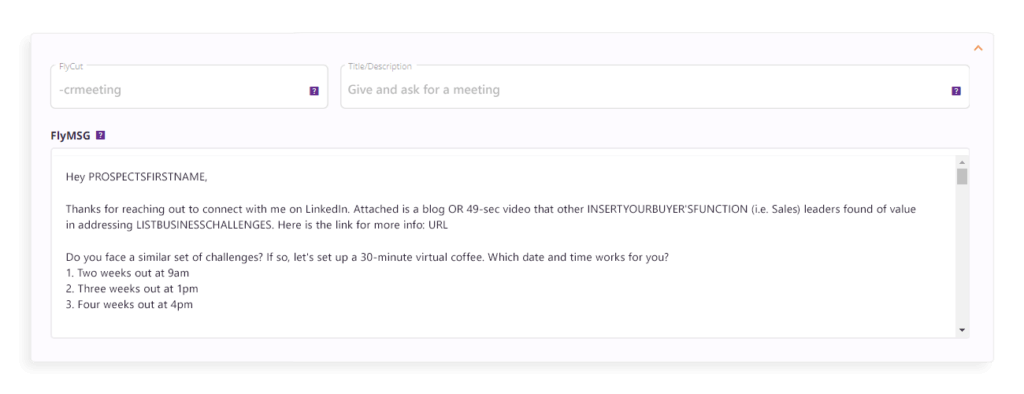
The second template helps you address an existing prospect with whom you haven’t connected online.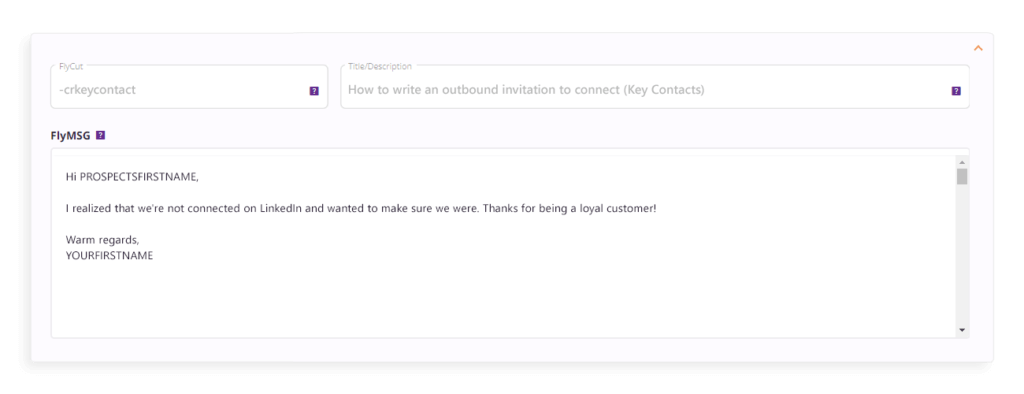
The last one you should use when you and the prospect have a common connection.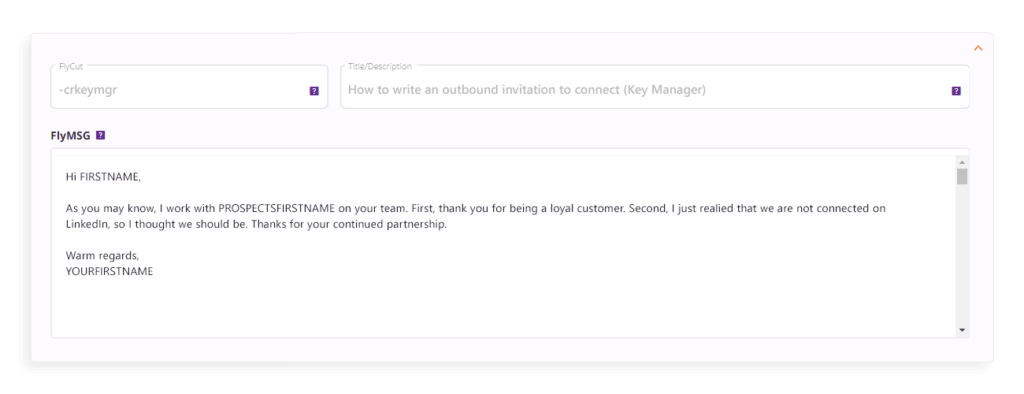
2. Prospecting Messages
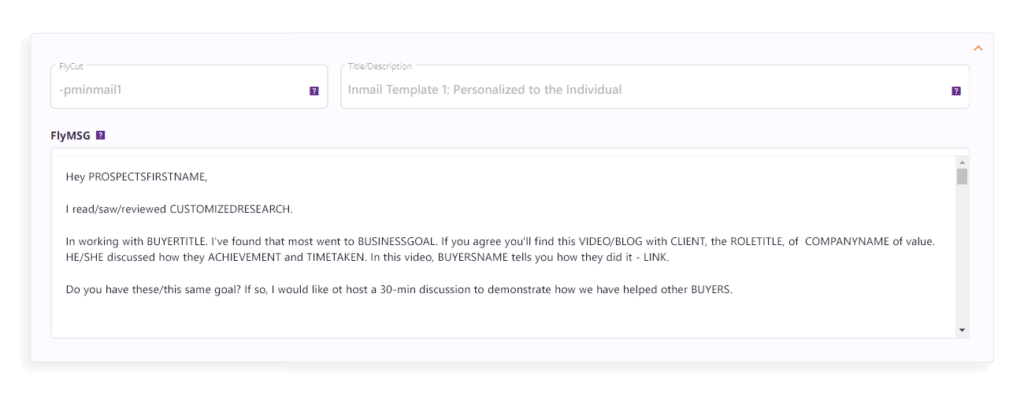 Prospecting is a significant part of the sales process. Your team probably sends countless emails and messages daily—leverage FlyMSG with sales prospecting tools to speed up the buying process further.
Prospecting is a significant part of the sales process. Your team probably sends countless emails and messages daily—leverage FlyMSG with sales prospecting tools to speed up the buying process further.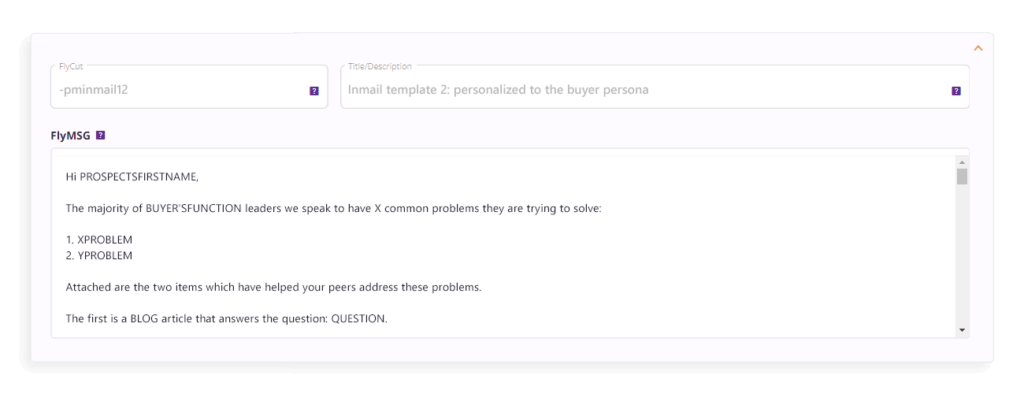
As you can see, two FlyPlates await you for prospecting.
3. Triggering Events
Sometimes it’s easier to begin a conversation when you have a good reason. For instance, it could be a customer’s birthday, work anniversary, or similar. We have FlyPlates for these occasions as well.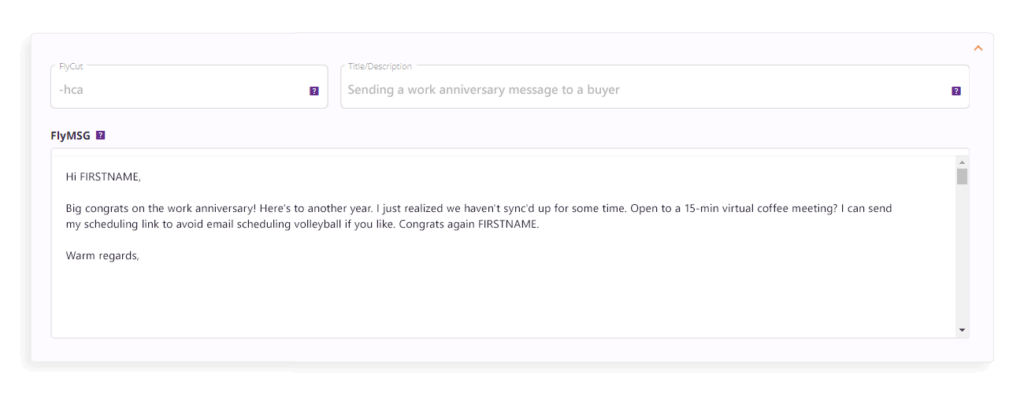
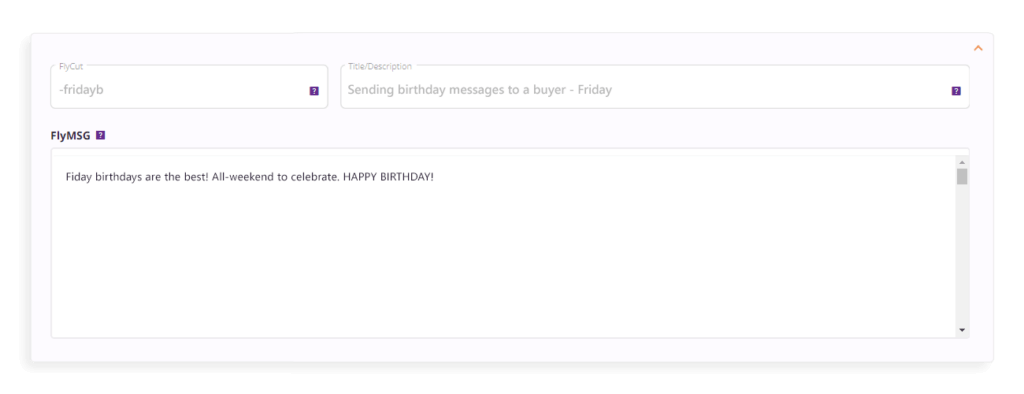
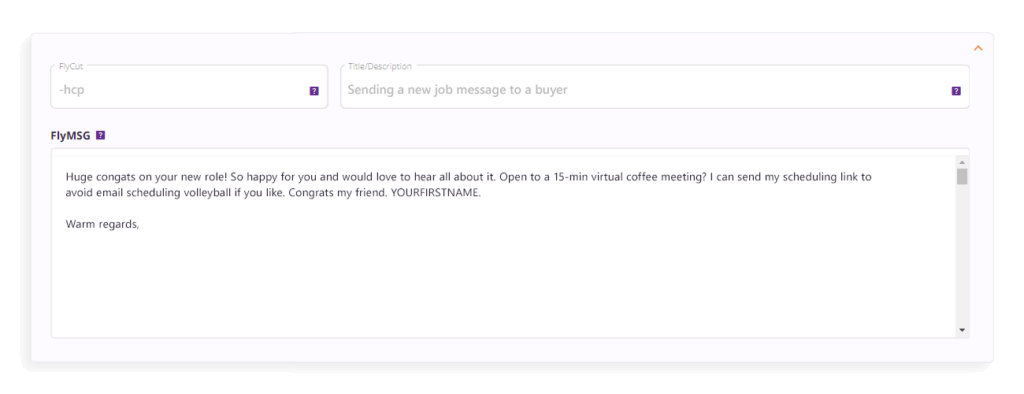
4. Upselling
FlyMSG is excellent for upselling as well. For instance, you can use it to promote a deal.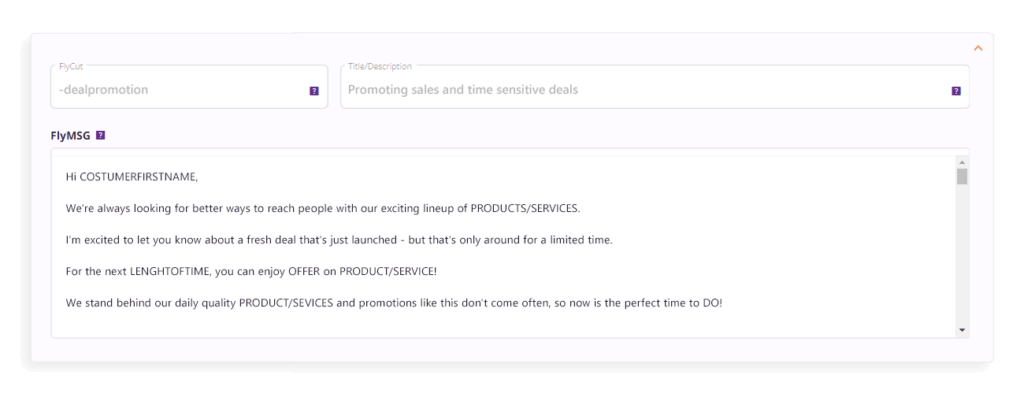
You can recommend another product to a customer.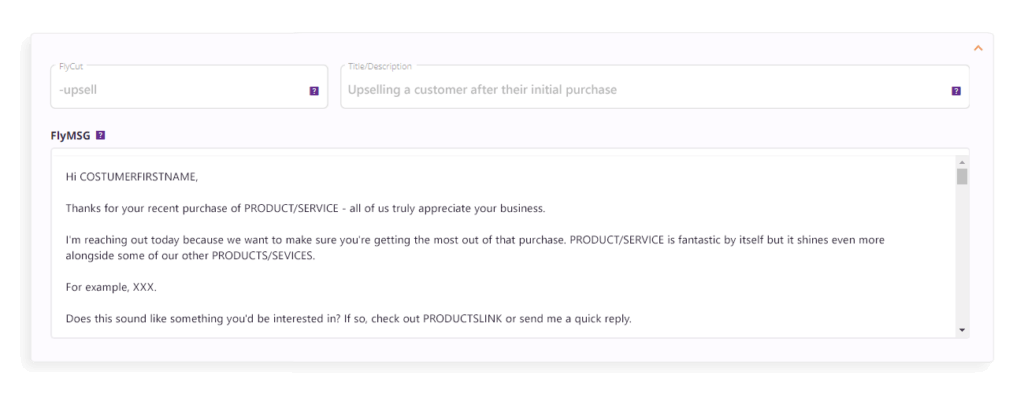
You can even target customers who abandon their carts.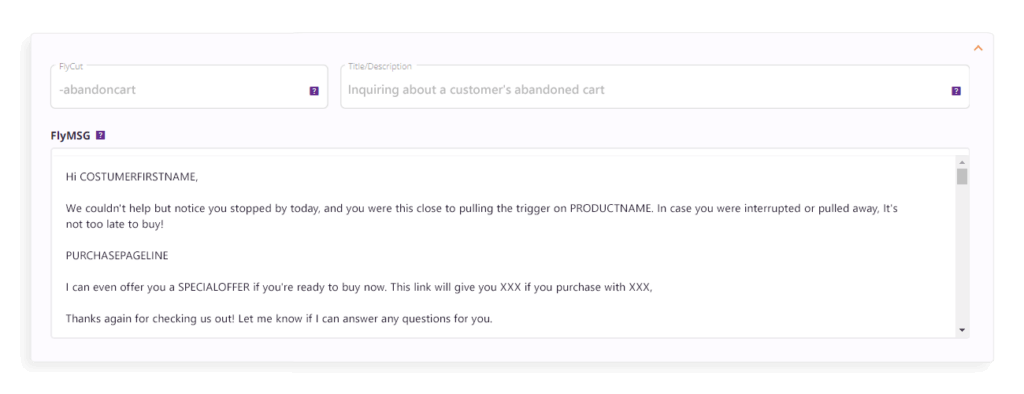
5. Welcome Messages
Welcome messages are another great way to connect with prospects. We suggest that your welcome messages provide value to your recipients. You can use the following FlyPlates for that purpose.
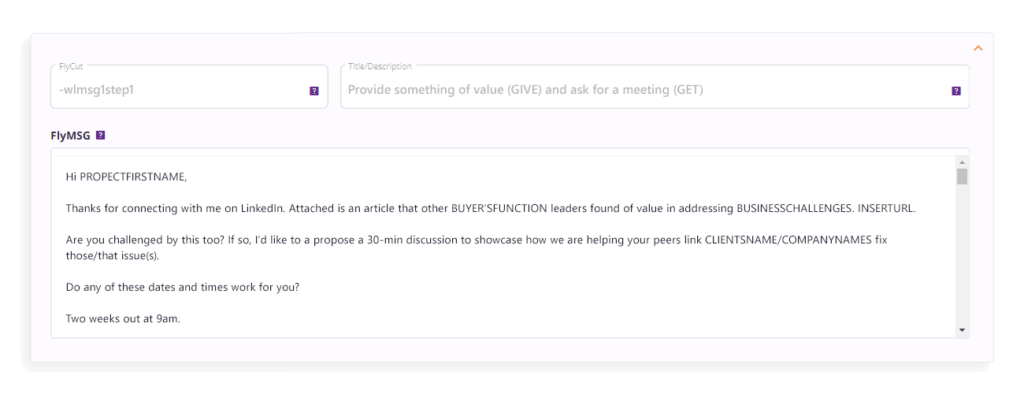
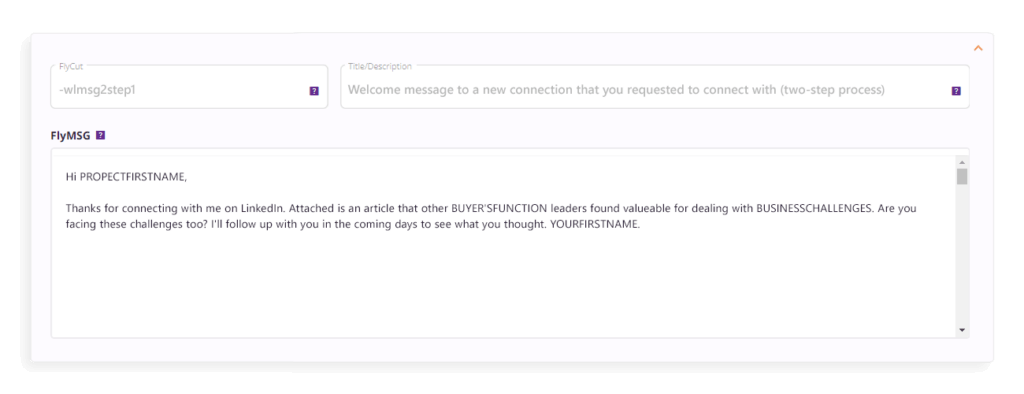
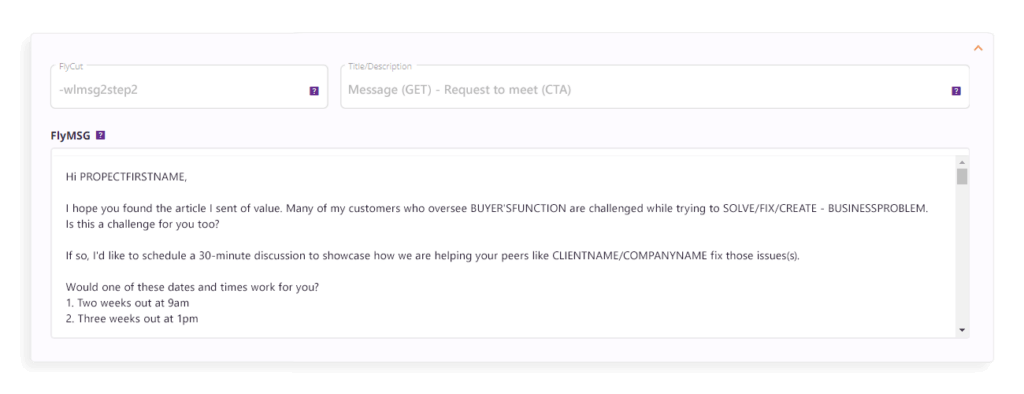
6. General Admin
Do you need a recommendation from a customer? We know how useful they are, especially on LinkedIn.
You can request a recommendation with our FlyPlate.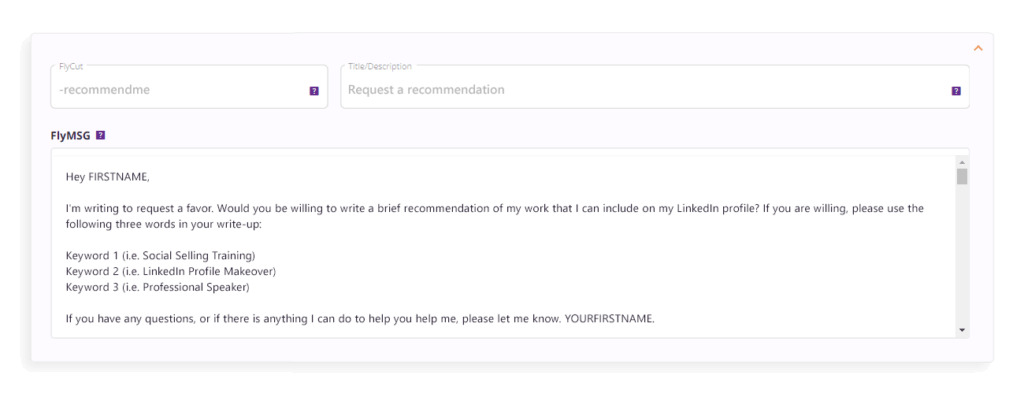
7. Cold Outreach
Want to do a cold outreach on LinkedIn? These two FlyPlates can help you.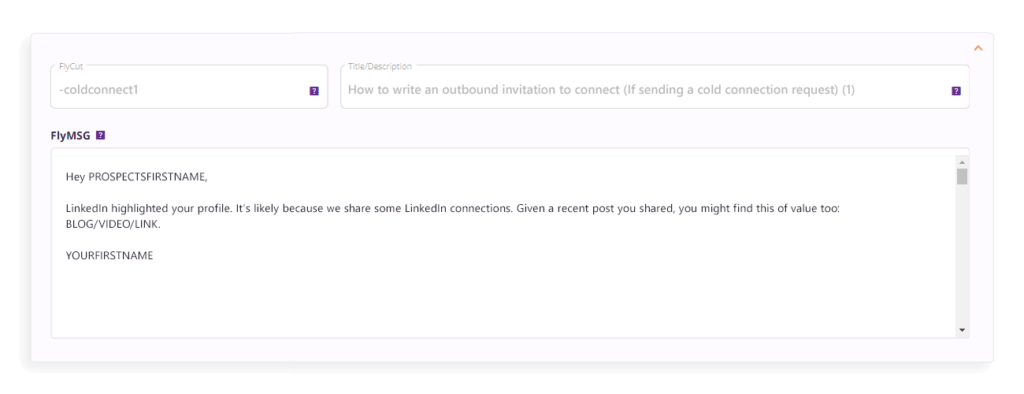
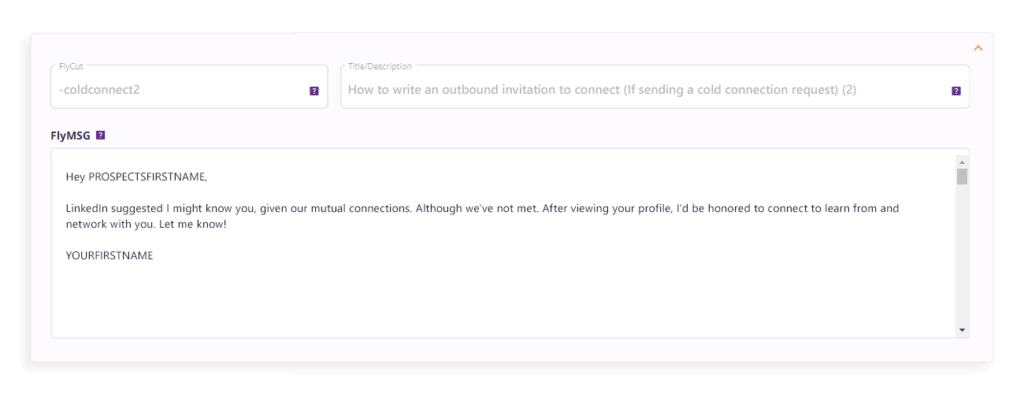
In case you want to send a cold email, you can use this template.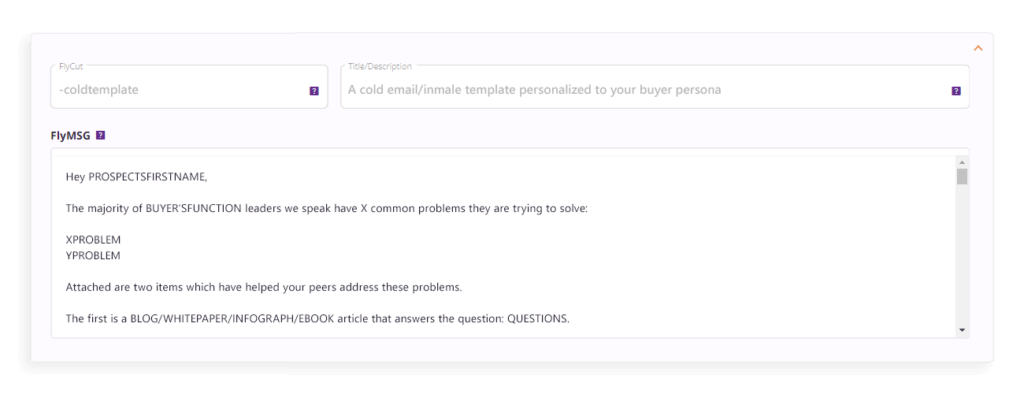
7 Reasons to Start Using FlyMSG Today
Here is why you need FlyMSG:
- Expand and replace text with just a few keystrokes
- Save over 20 hours per month
- Leverage over 200 FlyPlates for different use cases
- Create unique email templates, messaging snippets, and InMail messages
- Boost productivity as FlyMSG helps you insert messages instead of writing them
- Create FlyCuts to expand or replace a message while writing
- Find Zoom links, sales prospecting messages, and recruiting texts easily
FlyMSG will help you automate the written word and remove the time drain it takes to find, copy, paste or write sales content.
Sales Process: Wrapping Up

Every company should recognize the importance of crafting a unique sales process, meticulously moving through the sales stages, from the initial discovery call to dealing with objections and finally, closing the deal. The steps of the sale are integral to drawing customers, increasing revenue, and turning lead into leads and successful deals.
Selling products or services without a plan, without clear sales activities at each stage, will not yield the desired results.
That’s where FlyMSG comes in, a complete guide to efficiency in the sales process, whether you’re handling one stage or the entire journey. Don’t let your team write the same messages over and over again. Invest in our speed writing solution, give them access to pre-made templates or let them save their converting messages, enabling them to handle objections, engage prospects, and seal the deal more effectively.
With FlyMSG, you have the tools you need to transform leads into deals and make every deal a winning one.



 1- A Deeper Understanding of Your Prospects:
1- A Deeper Understanding of Your Prospects: 2- Improved Efficiency:
2- Improved Efficiency: 3. More Qualified Leads:
3. More Qualified Leads: 4. Increased Revenue:
4. Increased Revenue: 5. Better Strategies:
5. Better Strategies: 1. No Clear Picture
1. No Clear Picture 2. Lack of Procedures
2. Lack of Procedures 3. Failure to Understand Customers
3. Failure to Understand Customers 4. Inability to Find Solutions
4. Inability to Find Solutions 5. Missed Follow-Ups
5. Missed Follow-Ups Fear of Switching Sales Methodology
Fear of Switching Sales Methodology Having Long Sales Cycles
Having Long Sales Cycles Forgetting to Document a Sales Process
Forgetting to Document a Sales Process Losing Time on Unqualified Prospects
Losing Time on Unqualified Prospects 1. Define What Success Looks Like for Your Business
1. Define What Success Looks Like for Your Business 2. Identify Current Issues in Your Sales Process
2. Identify Current Issues in Your Sales Process 3. Find Out What Works for Your Sales Team
3. Find Out What Works for Your Sales Team 4. Create a Straightforward Sales Process With Measurable Objectives
4. Create a Straightforward Sales Process With Measurable Objectives 6. Define the Customer Journey
6. Define the Customer Journey 7. Set Responsibilities for the Sales Process Steps
7. Set Responsibilities for the Sales Process Steps 8. Run a Pilot to Test What Works and What Doesn’t
8. Run a Pilot to Test What Works and What Doesn’t 9. Train Sales Reps Continuously
9. Train Sales Reps Continuously 10. Run a Weekly Sales Rep Review
10. Run a Weekly Sales Rep Review 12. Find and Eliminate Bottlenecks
12. Find and Eliminate Bottlenecks 13. Use Data to Refine and Improve Continually
13. Use Data to Refine and Improve Continually 14. Implement Sales Productivity Tools in Your Sales Process
14. Implement Sales Productivity Tools in Your Sales Process




